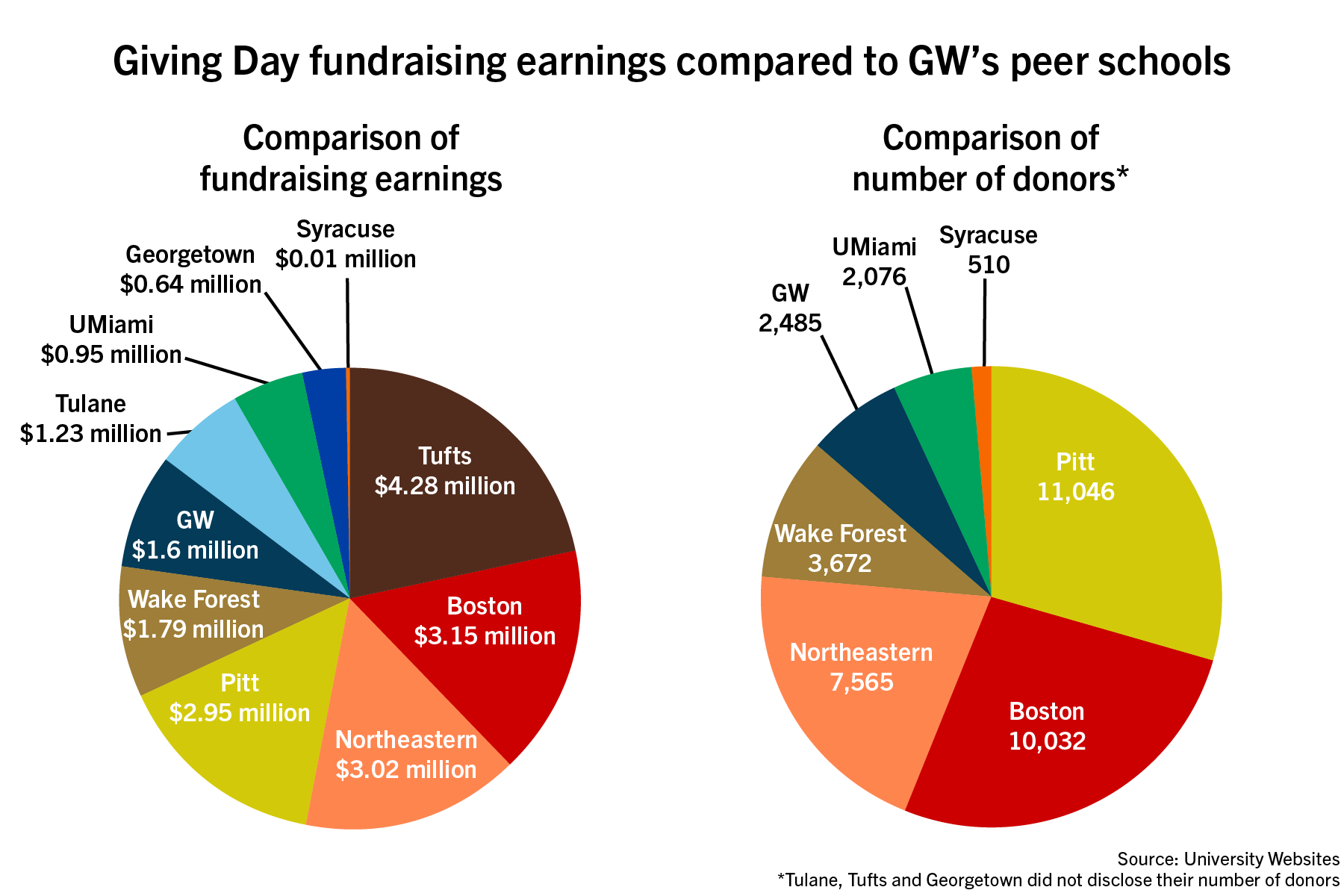GW’s Giving Day earnings ranked sixth among the University’s nine peer schools that had similar one-day fundraising initiatives so far this academic year.
Officials exceeded their goal to raise $1 million on Giving Day, a 24-hour period where officials try to raise as much money as possible through alumni, trustees and other community members’ donations, raking in more than $1.6 million from nearly 2,500 donors earlier this month. Experts in higher education fundraising said GW’s Giving Day haul of donations indicates that GW is reengaging with community members two years after the start of the pandemic.
Boston and Northeastern universities and the University of Pittsburgh did not set single donation goals, but all outraised GW, with all of their days of giving yielding about $3 million in donations from about 10,000 donors. Wake Forest University also garnered about $200,000 more in donations than GW during its annual Day of Giving but did not set any donation targets prior to the event.
Other peer institutions raised significantly less than GW, including Syracuse University – which raised about $12,000 from more than 500 donors, falling short of its original goal – and Georgetown University, which raised less than $650,000. The University of Miami and Tulane University both surpassed donor goals but raised less than GW by at least $400,000.
New York University has not made its total Giving Day fundraising public, but NYU officials said they received over 7,000 gifts. The universities of Rochester and Southern California have scheduled their Days of Giving for next month and will use the funds to expand student financial aid packages.
“We are thrilled with the turnout,” Patty Carocci, the associate vice president of alumni relations and annual giving, said in a release. “It shows how enthusiastic and dedicated the GW community is about coming together to support student aid.”
In last year’s Giving Day, officials fell short of their final $1 million goal by about $200,000 after continuously upping their original goal of $300,000 in donations throughout the day. This year, officials surpassed their goal of $1 million in a 24-hour period, most of which went toward expanding aid for Pell Grant-eligible students and other GW initiatives.
Officials launched a new “focused initiative” last October, aimed at increasing the amount of scholarships and aid available to Pell-eligible students at GW.

Nicholas Anastacio | Graphics Editor
Experts in higher education, administration and finance said this year’s Giving Day allowed officials to “reconnect” with students, alumni and community members who may have felt less involved with the school throughout the pandemic.
Blake Absher – the assistant vice president of the Wake Forest Fund, a fundraising initiative at Wake Forest University – said university leaders should compare their Giving Day funding to their peers if they have similar fundraising goals. He said Wake Forest has been directing much of its fundraising toward expanding scholarship aid, similar to GW’s “focused initiative.”
Wake Forest raised slightly more than GW, totaling almost $1.8 million in donations with about 3,700 donors.
“Comparing yourself to other schools on the dollars is interesting, but it’s sometimes meaningless because you’re not really, really focused on the same things,” he said.
Absher said Giving Days generate “urgency” to donate during a limited time and help alumni to reconnect with their universities.
Absher said Wake Forest directs its donations toward areas of greatest need like scholarships. He said his university accepted about $600,000 in “unrestricted money” that wasn’t donated to a specific college or program of the nearly $1.8 million raised on its most recent Giving Day last fall.
“Giving Day provides a possible solution as it garners alumni’s ‘excitement and enthusiasm,’” Absher said.
During GW’s Giving Day this year, alumni made 46 percent of donations, making them the largest group of donors. Alumni participation decreased by about 20 percent compared to last year’s Giving Day when alumni comprised 66 percent of the total donors.
Absher said Wake Forest’s Giving Day took place in the fall when COVID-19 rates were lower, but schools that held their Giving Days in the spring semester saw lower turnout because of concerns from rising COVID-19 cases.
“A lot of schools that have it in the spring had a very traumatic impact,” he said.
Joseph Paris, an associate professor of higher education at Temple University, said many of GW’s Giving Day funds will be “unrestricted,” so the University can direct the donations toward their priority targets like scholarships. He said nonprofit organizations like GW can designate unrestricted donations to any area in the University but are bound by donor intent when they receive donations with specific instructions for where the money should go.
Donors during Giving Day had the option to direct their donations toward a specific college, program, department or student organization, in addition to being able to donate generally toward the University.
Paris said officials can use unrestricted funds to support academic programs, scholarships, athletics or faculty members through endowed professorships.
“Decision-making in higher education is driven by an institution’s mission and strategic plan,” he said. “These objectives could include increasing enrollment headcount, net tuition revenue, student quality, access, affordability or student diversity, among other possibilities.”







